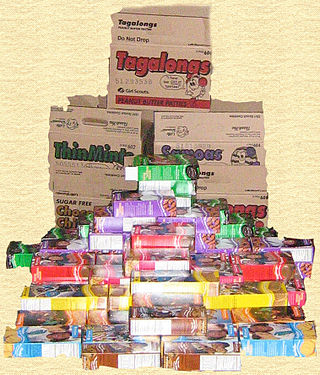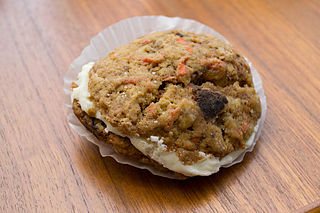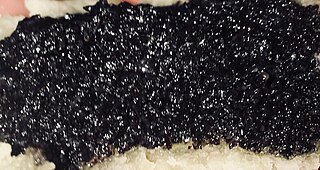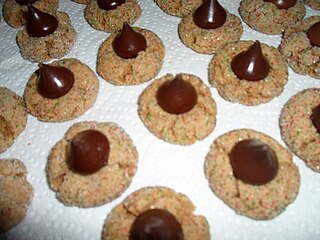
A cookie or biscuit is a baked snack or dessert that is typically small, flat, and sweet. It usually contains flour, sugar, egg, and some type of oil, fat, or butter. It may include other ingredients such as raisins, oats, chocolate chips, or nuts.

Dessert is a course that concludes a meal. The course consists of sweet foods, such as cake, biscuit, ice cream and possibly a beverage such as dessert wine and liqueur. Some cultures sweeten foods that are more commonly savory to create desserts. In some parts of the world there is no tradition of a dessert course to conclude a meal.

New England cuisine is an American cuisine which originated in the New England region of the United States, and traces its roots to traditional English cuisine and Native American cuisine of the Abenaki, Narragansett, Niantic, Wabanaki, Wampanoag, and other native peoples. It also includes influences from Irish, French-Canadian, Italian, and Portuguese cuisine, among others. It is characterized by extensive use of potatoes, beans, dairy products and seafood, resulting from its historical reliance on its seaports and fishing industry. Corn, the major crop historically grown by Native American tribes in New England, continues to be grown in all New England states, primarily as sweet corn although flint corn is grown as well. It is traditionally used in hasty puddings, cornbreads and corn chowders.

A chocolate chip cookie is a drop cookie that features chocolate chips or chocolate morsels as its distinguishing ingredient. Chocolate chip cookies are claimed to have originated in the United States in 1938, when Ruth Graves Wakefield chopped up a Nestlé semi-sweet chocolate bar and added the chopped chocolate to a cookie recipe; however, historical recipes for grated or chopped chocolate cookies exist prior to 1938 by various other authors.

Girl Scout Cookies are cookies sold by Girl Scouts in the United States to raise funds to support Girl Scout councils and individual troops. The cookies are widely popular and are commonly sold by going door-to-door, online, through school or town fundraisers, or at "cookie booths" set up at storefronts. The program is intended to both raise money and improve the financial literacy of girls. During an average selling season, more than one million girls sell over 200 million packages of cookies and raise over $800 million. The first known sale of cookies by Girl Scouts was in 1917. Cookie sales are organized by 112 regional Girl Scout councils who select one of two national bakeries to buy cookies from.

Cheesecake is a dessert made with a soft fresh cheese, eggs, and sugar. It may have a crust or base made from crushed cookies, graham crackers, pastry, or sometimes sponge cake. Cheesecake may be baked or unbaked, and is usually refrigerated.

Fudge is a type of confection that is made by mixing sugar, butter and milk. It has its origins in the 19th century United States, and was popular in the women's colleges of the time. Fudge can come in a variety of flavorings depending on the region or country it was made; popular flavors include fruit, nut, chocolate and caramel. Fudge is often bought as a gift from a gift shop in tourist areas and attractions.

A fluffernutter is a sandwich made with peanut butter and marshmallow creme usually served on white bread. Variations of the sandwich include the substitution of wheat bread and the addition of various sweet, salty, and savory ingredients. The term fluffernutter can also be used to describe other food items, primarily desserts, that incorporate peanut butter and marshmallow creme.

Dessert bars or simply bars or squares are a type of American "bar cookie" that has the texture of a firm cake or softer than usual cookie. They are prepared in a pan and then baked in the oven. They are cut into squares or rectangles. They are staples of bake sales and are often made for birthdays. They are especially popular during the holidays, but many people eat them all year. Many coffee shops and bakeries also offer the treats. Popular flavors include peanut butter bars, lemon bars, chocolate coconut bars, pineapple bars, apple bars, almond bars, toffee bars, chocolate cheesecake bars and the "famous" seven-layer bar. In addition to sugar, eggs, butter, flour and milk, common ingredients are chocolate chips, nuts, raspberry jam, coconut, cocoa powder, graham cracker, pudding, mini-marshmallows and peanut butter. More exotic bars can be made with ingredients including sour cream, rhubarb, pretzels, candies, vanilla, raisins, and pumpkin. The Nanaimo bar is a bar dessert that requires no baking and is named after the city of Nanaimo, British Columbia.
The following outline is provided as an overview of and topical guide to chocolate:

Sponge cake is a light cake made with eggs, flour and sugar, sometimes leavened with baking powder. Some sponge cakes do not contain egg yolks, like angel food cake, but most of them do. Sponge cakes, leavened with beaten eggs, originated during the Renaissance, possibly in Spain. The sponge cake is thought to be one of the first non-yeasted cakes, and the earliest attested sponge cake recipe in English is found in a book by the English poet Gervase Markham, The English Huswife, Containing the Inward and Outward Virtues Which Ought to Be in a Complete Woman (1615). Still, the cake was much more like a cracker: thin and crispy. Sponge cakes became the cake recognised today when bakers started using beaten eggs as a rising agent in the mid-18th century. The Victorian creation of baking powder by English food manufacturer Alfred Bird in 1843 allowed the addition of butter to the traditional sponge recipe, resulting in the creation of the Victoria sponge. Cakes are available in many flavours and have many recipes as well. Sponge cakes have become snack cakes via the Twinkie.

Instant pudding is an instant food product that is manufactured in a powder form and used to create puddings and pie filling. It is produced using sugar, flavoring agents and thickeners as primary ingredients. Instant pudding can be used in some baked goods.

A carrot cake cookie is a cookie prepared with ingredients that provide a flavor and texture similar to carrot cake.

An apple cider cookie is a cookie that is prepared and flavored with apple cider. Some versions use apple cider in the cookie dough, while others have a glaze or icing prepared with apple cider. Some apple cider cookies use apple cider in both the cookie dough and glaze or icing. Typical ingredients include apple cider, flour, sugar or brown sugar, vegetable oil or butter, spices and baking soda. Additional ingredients may include apple butter, applesauce, chopped or dried apples, nuts and dates. Vegan varieties of the apple cider cookie exist.

A sandwich cookie, also known as a sandwich biscuit, is a type of cookie made from two thin cookies or medium cookies with a filling between them. Many types of fillings are used, such as cream, ganache, buttercream, chocolate, cream cheese, jam, peanut butter, lemon curd, or ice cream.

Poppy seed paste, also known as mohn, is a common ingredient in Ashkenazi Jewish pastries and desserts. It is made from ground poppy seeds and additional sweeteners. Examples of pastries featuring the filling include mohn kichel, babka, and, most famously, hamantashen. In Jewish cuisine, the filling is traditionally referred to as mohn, the word for poppy in both Yiddish and German. Poppy seed-filled pastries are particularly associated with the holiday of Purim.

The peanut butter blossom cookie originated in 1957, is made with a peanut butter cookie dough, and is topped with a piece of chocolate candy. The cookie is considered a snack or dessert and is often served at events or during holidays in the United States.
Pie in American cuisine has roots in English cuisine and has evolved over centuries to adapt to American cultural tastes and ingredients. The creation of flaky pie crust shortened with lard is credited to American innovation.

















